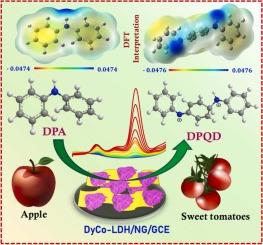Metal-organic framework-derived hierarchical flower-like DyCo-layered double hydroxide amalgamated nitrogen-doped graphene for diphenylamine detection in fruit samples: Theoretical density functional theory interpretation
IF 8
1区 化学
Q1 CHEMISTRY, ANALYTICAL
引用次数: 0
Abstract
Diphenylamine (DPA) is an environmental pollutant that can be potentially toxic. As a result, it is crucial to use basic and affordable analytical techniques to detect DPA. Electrochemical detection of DPA is a cost-effective and simple method. Modifying the electrodes with nanomaterials can enhance the electrochemical characteristics and sensitivity of the sensor. Herein, metal-organic framework (MOF) derived dysprosium cobalt-layered double hydroxide integrated nitrogen-doped graphene (DyCo-LDH/NG) is reported for the fabrication of the DPA sensing platform. The electrochemical oxidation of DPA is enhanced by the exceptional electrocatalytic activity and electron transfer properties of the DyCo-LDH/NG nanocomposite. Interestingly, the glassy carbon electrode (GCE) modified with DyCo-LDH/NG nanocomposite demonstrates a large linear detection range (0.05–470 μM) and a low limit of detection (0.012 µM). The density functional theory (DFT) study is employed to examine the energy levels and electron transfer sites of DPA during the electro-oxidation process. Furthermore, the practical efficiency test of the developed DPA sensor demonstrates a substantial recovery in fruit samples.

用于水果样品中二苯基胺检测的金属有机框架衍生分层花朵状 DyCo 层双氢氧化物汞齐化氮掺杂石墨烯:理论密度泛函理论解释
二苯胺(DPA)是一种具有潜在毒性的环境污染物。因此,使用基本且经济实惠的分析技术来检测 DPA 至关重要。电化学检测 DPA 是一种经济有效且简单的方法。用纳米材料修饰电极可以提高传感器的电化学特性和灵敏度。在此,研究人员采用金属有机框架(MOF)衍生的镝钴层状双氢氧化物集成掺氮石墨烯(DyCo-LDH/NG)来制造 DPA 传感平台。DyCo-LDH/NG 纳米复合材料卓越的电催化活性和电子传递特性增强了 DPA 的电化学氧化能力。有趣的是,DyCo-LDH/NG 纳米复合材料修饰的玻璃碳电极(GCE)具有较大的线性检测范围(0.05-470 μM)和较低的检测限(0.012 µM)。利用密度泛函理论(DFT)研究了电氧化过程中 DPA 的能级和电子转移位点。此外,对所开发的 DPA 传感器进行的实际效率测试表明,其在水果样品中的回收率很高。
本文章由计算机程序翻译,如有差异,请以英文原文为准。
求助全文
约1分钟内获得全文
求助全文
来源期刊

Sensors and Actuators B: Chemical
工程技术-电化学
CiteScore
14.60
自引率
11.90%
发文量
1776
审稿时长
3.2 months
期刊介绍:
Sensors & Actuators, B: Chemical is an international journal focused on the research and development of chemical transducers. It covers chemical sensors and biosensors, chemical actuators, and analytical microsystems. The journal is interdisciplinary, aiming to publish original works showcasing substantial advancements beyond the current state of the art in these fields, with practical applicability to solving meaningful analytical problems. Review articles are accepted by invitation from an Editor of the journal.
 求助内容:
求助内容: 应助结果提醒方式:
应助结果提醒方式:


